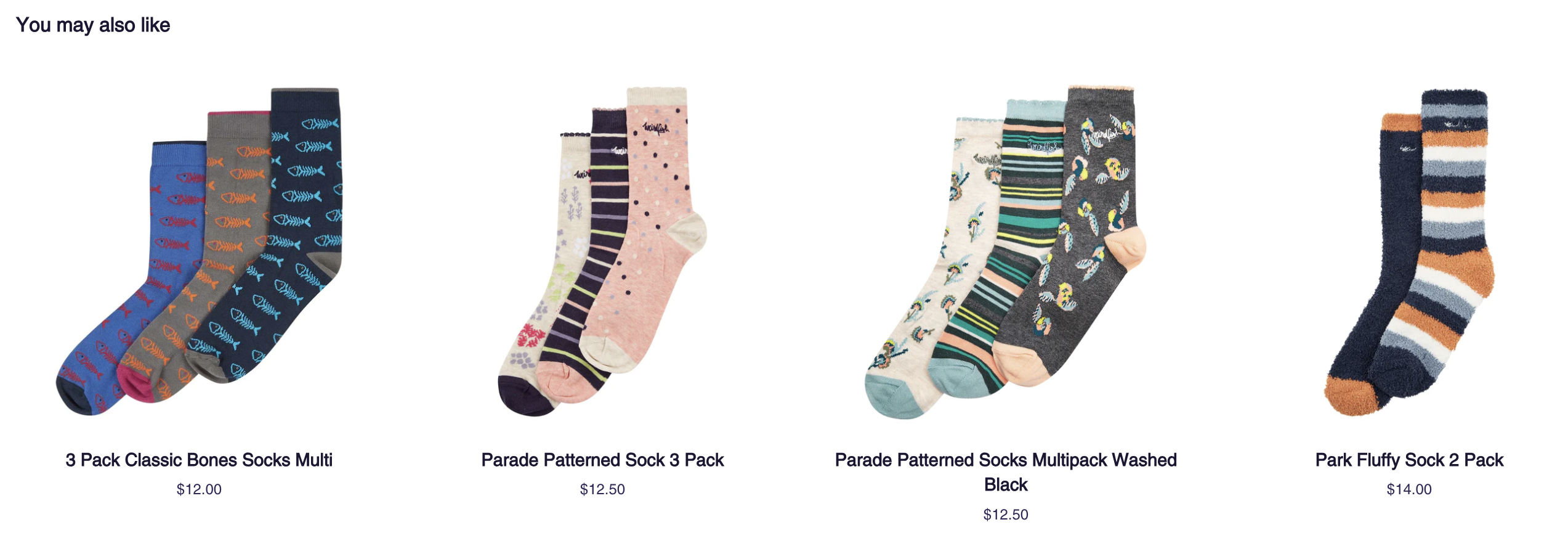Recommendations
Our Loomi AI-powered product recommendations enhance your website by using advanced techniques to personalize content for your customers as they shop. By analyzing customer behavior and product details via statistics, rules, or machine learning, our system provides personalized suggestions designed to:
- Boost engagement.
- Strengthen brand loyalty.
- Encourage customers to purchase additional or related products.
This is a Standard tier feature powered by Loomi AI.

Example of recommendations on a website showing a panel with related products.
Dictionary
This manual uses the following terms and definitions:
User
A visitor, potential customer, or current customer of your webpage generating events.
Item
A product that users can purchase (used interchangeably with "product").
Personalization
Customizing experiences to treat each user individually. This may include using Jinja for design elements like text and color or recommending items based on user preferences.
Recommender system
A method for selecting items for users, usually personalized. Also referred to as the “recommendation model” or the “recommender system (RS).”
Placement
The webpage locations where recommendations are integrated, such as the homepage, product detail page, or basket page.
Engine
The deployed RS as a service, identified by a unique ID. This ID is the last part of the URL when viewing the RS model in Bloomreach Engagement. For more details, refer to Where to find the ID campaign_id.
Fallback
A non-personalized recommendation strategy used when the main engine fails, such as when the engine is broken or a new user appears with no prior data.
Similarity score
A number between 0 and 1 indicating the similarity between two items.
Top N items
A list of the top N items, ordered by relevance using the criteria or model employed for recommendations.
Interaction
The connection between a user and an item, represented by the set {user, item, time, action}.
Here’s an example of an interaction displayed below:
| user | item | time | action |
|---|---|---|---|
| user_123 | item_45 | 2019-01-01-12:00:00 | view_item |
Recommendation systems
In the e-commerce world, we can define the recommendation problem as: “Given all data about users and items (metadata, interactions), find the best items for a given user to recommend that will maximize metric relevant for the business.”
Most of the algorithms used in Bloomreach Engagement rely on either catalog metadata (such as description or categories) or collected user-item interactions (events like purchase_item or view_item).
Recommendation systems can be categorized into four segments based on:
- Methodology:
- Rule-based: using simple heuristics.
- Machine learning (ML) algorithms: also known as artificial intelligence (AI) models.
- Level of personalization:
- Personalized
- Non-personalized
Rule-based recommendations
Non-personalized:
- Use simple statistical methods to identify items that are suitable for everyone.
- Examples: top-selling or brand-new items.
Personalized:
- Apply statistical methods to analyze each customer individually.
- Examples: last-seen items and recent interactions.
AI or ML model recommendations:
Non-personalized:
- Train AI models primarily on catalog metadata.
- Examples: attributes matching, text models, image models, and items bought together.
Personalized:
- Leverage user-item interactions, usually in combination with other RS.
- Examples: Often incorporate other systems like collaborative filtering and factorization for enhanced capabilities.
Note
In all ML- and AI-based models, items are ordered based on their calculated relevancy.
Related articles
Explore more on product recommendations.
Updated 10 months ago
